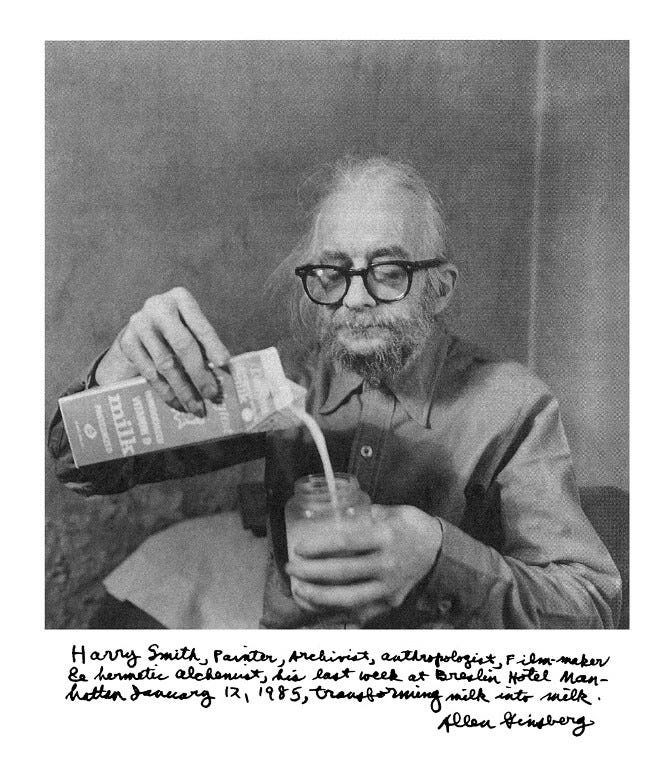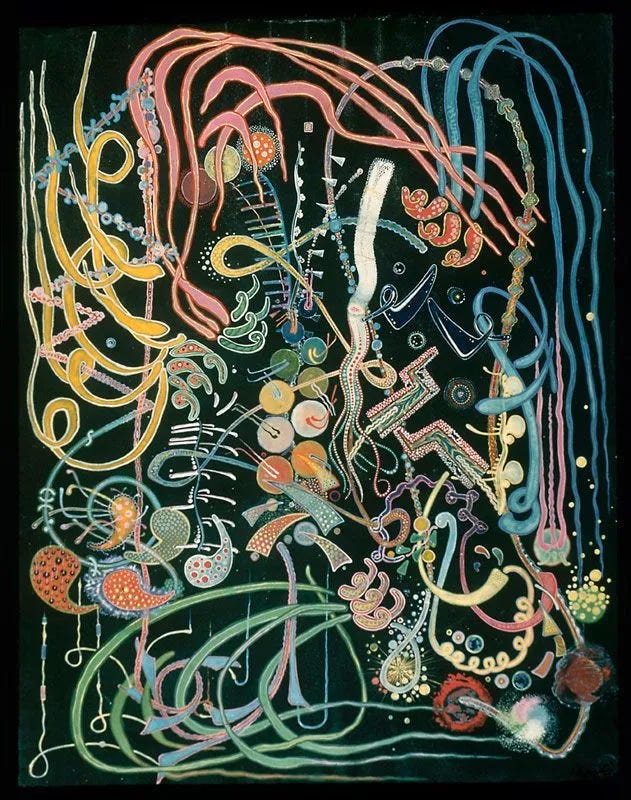Transforming Milk into Milk
"You're only as young as the last time you changed your mind."-Timothy Leary
I realized that I missed the centennial anniversary of the birth of Harry Smith, which was a few days ago, May 29th. Harry Smith was a modern-day Renaissance man: musicologist, filmmaker, magickian, philosopher, inventor, artist, anon…a collector of paper airplanes… He is probably best known for the Anthology of American Folk Music that he compiled and produced for Moe Asch and Folkways in 1952. At the time, the collection introduced the world to so many recordings released in the mid-twenties to mid-thirties that had been forgotten. Many of these recordings…and the musicians behind them…have become woven into America’s culture since and now the set is a Holy Grail to anyone wanting to dip into American music history. I have a replica wooden box-encased reissue of the collection front and center in my living room, just under the turn table near my Oxford English Dictionary.
The fact that Harry Smith would only be 100 at this time is somewhat stunning, because he looked anciently elderly by the time he was in his 60s (he died when he was 68 in 1991). Smith lived life very much on the dole, never finding financial success in his bohemian lifestyle and pursuits, spending the money Allen Ginsburg regularly gave him on alcohol and his collecting obsessions, often resorting to stealing what he needed to survive (or what he just thought he needed). Taking care of himself was secondary to taking care of his obsessions, and he burned life’s candle brilliantly. The famous photo that Ginsburg took of Smith in 1985 (above) shows an already withered human at 62.
There is much going on around Smith’s centennial. Author John Szwed, who masterfully wrote the biographies of Sun Ra, Miles Davis, Jelly Roll Morton, Alan Lomax, and Billie Holiday (which I have not read, yet hear is fantastic) has finished his book on Harry which is coming out in August. In October, The Whitney is opening an expansive Harry Smith exhibit which will feature “paintings, drawings, experimental films, designs, and examples of Smith’s collecting alongside his historic folk music collection.” If you want to start digging into Smith’s life and work beforehand, there is a fascinating, deep-digging documentary on Smith called American Magus that is available in rank presentation via youtube.
One of the main interviewees of American Magus is Smith’s friend Lionel Ziprin. Both bohemians roaming the streets of New York in the 50s and 60s, Smith knocked on Ziprin’s door looking to record Ziprin’s grandfather, Rabbi Naftali Zvi Margolies Abulafia, who was the holder of ancient, at times extinct, Jewish musical liturgy and melodies. Ziprin never figured out how Harry had heard about his grandfather or how he found Lionel’s address. The recordings were eventually “released” (I say in quotes because the only copy I have ever seen was in Lionel Ziprin’s apartment in the lower east side) as a 15-piece 78 set and yet were still largely forgotten until journalist Jon Kalish did a piece about them on NPR’s Weekend Edition. The piece stirred up the interest of myself and my compatriots of The Idelsohn Society for Musical Preservation, a society driven to preserve, and tell the tales behind, recorded Jewish music. My friend Roger Bennet and I met with Lionel to try and get to hear the recordings.
And while the Rabbi Abulafia story is one for a different day, what came very clear is that through the process of recording his grandfather, Lionel and Harry became close friends…a friendship that continued til Harry’s death. The hours I sat with Lionel in his apartment were hours filled with stories, many of which included Harry—Harry the running mate…Harry the crazed weirdo…Harry the mystic…Harry who was always getting the two of them into something utterly crazy. Lionel saw angels and experienced miracles; Harry had cosmic explanations for them.
During the 50s, Lionel had a greeting card company with his wife Johanna (the muse behind the Bob Dylan song Visions of Johanna) called Ink Weed Studios. The cards, which have since been the heart of an exhibit in New York a few years ago, are colorful, bodacious…surreal. One late-night after Lionel’s passing I was on one of my on-line search-and-collecting missions when I found a set of Ink Weed Studio greeting cards available on E-Bay…greetings cards supposedly to be used for baby showers, showing fetuses hanging out in the womb, throwing one-liners at each other (NOTE: these are in no way anti-abortion propaganda. It was a different time). To my complete bewilderment, when the set arrived, I discovered a few of the cards had a fetus referred to as “Harry.” This can’t be a mere coincidence.
As one of the cards suggests: Harry was always rushing around, driven by a project or delving into some mad mind trip of a journey. He was one of the people, along with Ginsburg and Ed Saunders of the Fugs, who tried to levitate and exorcise the Pentagon during the war in Vietnam1. When he was not doing that, he was painting and drawing and making crazy, beautiful underground films full of strange lines, shapes, and colors. He designed tarot cards and collected Ukrainian Easter Eggs and records and “anything shaped like a hamburger.2” His letters, artworks, collections and various other projects have been given to the Smithsonian, where they are being made accessible to a public, attempting to show the depth of Harry Smith’s life outputs. Harry Smith was one of those types of humans that went through life as an obscure counter-cultural figure. But as Allen Ginsburg and a few others realized, he had a line into some core component of what makes the world rotate…of what makes our collective existence interesting, important. He saw what most do not see…connecting dots that had not even been on the same graph before. His Anthology of American Folk Music would have been enough to prove his incredible cultural vision. But he did so much more.
Ilya Kabakov, Pioneering Installation Artist and Gimlet-Eyed Critic of Russia, Dies at 89
“Ilya Kabakov, an artist whose expansive works sharply directed their aim at the imploded dreams of the Soviet Union, ushering in new possibilities for installation art in the process, died on Saturday at 89. In vast installations, Kabakov took up the many failures of the Soviet Union, where he lived for decades before departing for the West in 1987. By building out the worlds of imagined characters via room-size artworks, Kabakov offered heightened versions of the reality he lived for viewers across the globe.”
Kieran Culkin Confides in Taika Waititi About the End of Succession
I had to post at least ONE article that circled around the obsession with Succession. What a great show.
A forgotten children's book by Langston Hughes and Elmer W. Brown emerges in Cleveland
“Artist Elmer W. Brown and writer Langston Hughes met in the 1930s at Karamu House, where Brown was an actor and graphic artist and Hughes a playwright. Their friendship evolved into a partnership as they tried to publish a children's picture book, ‘The Sweet and Sour Animal Book,’ featuring poems by Hughes and illustrations by Brown. The book was never published, but it’s finding new life in 2023 thanks to a group of students and a determined art educator…”
The Humor and Hell of Daniel Johnston’s Art
“For both his longtime followers and newcomers to his work, Los Angeles bookstore ‘des pair’ is showing a gallery exhibition of Johnston’s archival drawings from the ‘80s. In collaboration with Lee Foster of Electric Lady Studios who works closely with Johnston’s estate, this is a rare opportunity to see his work up-close-and-personal.”
Um: “Start Me Up” Coffee kit? Really?
Why Edith Hamilton Feared the Decline of Individualism More Than Atomic Bombs
A great read about author/educator Edith Hamilton, who died 60 years ago today. Who in my generation did not come in contact with one of her books on Greek myths? That being said, this piece by Lawrence W. Reed goes deep into her ideologies that helped drive the work.
I Sing The Body Electric Pt. 9
By Walt Whitman
O my body! I dare not desert the likes of you in other men and women, nor the likes of the parts of you,
I believe the likes of you are to stand or fall with the likes of the soul, (and that they are the soul,)
I believe the likes of you shall stand or fall with my poems, and that they are my poems,
Man’s, woman’s, child, youth’s, wife’s, husband’s, mother’s, father’s, young man’s, young woman’s poems,
Head, neck, hair, ears, drop and tympan of the ears,
Eyes, eye-fringes, iris of the eye, eyebrows, and the waking or sleeping of the lids,
Mouth, tongue, lips, teeth, roof of the mouth, jaws, and the jaw-hinges,
Nose, nostrils of the nose, and the partition,
Cheeks, temples, forehead, chin, throat, back of the neck, neck-slue,
Strong shoulders, manly beard, scapula, hind-shoulders, and the ample side-round of the chest,
Upper-arm, armpit, elbow-socket, lower-arm, arm-sinews, arm-bones,
Wrist and wrist-joints, hand, palm, knuckles, thumb, forefinger, finger-joints, finger-nails,
Broad breast-front, curling hair of the breast, breast-bone, breast-side,
Ribs, belly, backbone, joints of the backbone,
Hips, hip-sockets, hip-strength, inward and outward round, man-balls, man-root,
Strong set of thighs, well carrying the trunk above,
Leg-fibres, knee, knee-pan, upper-leg, under-leg,
Ankles, instep, foot-ball, toes, toe-joints, the heel;
All attitudes, all the shapeliness, all the belongings of my or your body or of any one’s body, male or female,
The lung-sponges, the stomach-sac, the bowels sweet and clean,
The brain in its folds inside the skull-frame,
Sympathies, heart-valves, palate-valves, sexuality, maternity,
Womanhood, and all that is a woman, and the man that comes from woman,
The womb, the teats, nipples, breast-milk, tears, laughter, weeping, love-looks, love-perturbations and risings,
The voice, articulation, language, whispering, shouting aloud,
Food, drink, pulse, digestion, sweat, sleep, walking, swimming,
Poise on the hips, leaping, reclining, embracing, arm-curving and tightening,
The continual changes of the flex of the mouth, and around the eyes,
The skin, the sunburnt shade, freckles, hair,
The curious sympathy one feels when feeling with the hand the naked meat of the body,
The circling rivers the breath, and breathing it in and out,
The beauty of the waist, and thence of the hips, and thence downward toward the knees,
The thin red jellies within you or within me, the bones and the marrow in the bones,
The exquisite realization of health;
O I say these are not the parts and poems of the body only, but of the soul,
O I say now these are the soul!
Ed Sanders (vocalist, The Fugs): We had a gig that weekend at a psychedelic theatre, the Ambassador, in Washington. Me and Tuli Kupferberg used our salary from the gig to pay for rental of the things we needed for the exorcism – a flat-bed truck, a PA system, a cow, some flowers and so on.
One man who had a major influence was my friend Harry Smith, the film-maker and music anthologist, who was also a magician. I went to Harry when the idea first came up, to get advice on how to exorcise the Pentagon. He advised us to circle the Pentagon with a trail of corn meal, and to consecrate the four directions: north, south, east and west.
It was Harry who advocated the use of a cow, which we acquired from a farm in Virginia. We painted it to represent the Egyptian goddess Hathor, but the authorities prevented us from bringing it. We also had made arrangements for a plane to fly over and drop daisies on to the Pentagon while we were performing the exorcism, but the authorities at the airport interceded.
https://www.newyorker.com/magazine/2020/10/05/harry-smiths-musical-catalogue-of-human-experience













